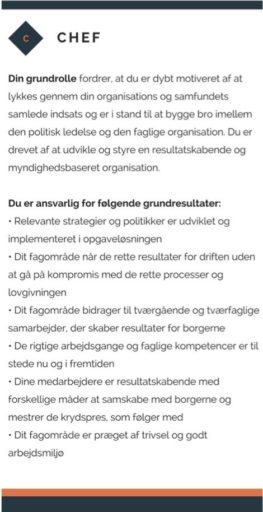Vesterby School has become a hot potato in the administration. From being a prime example of good school management, it has now become the problem child. Ole, the head of school, had actually had a good impression of the new head of school, Bente, who had been obviously enthusiastic when he talked about the strategy at the head of school conference as the flowers that would grow. But right now, Vesterby School is growing nothing but weeds, and the school committee is constantly pressuring Ole about what he is doing to get the school back on track. Ole tries to gain the committee's trust by guaranteeing that from now on he will follow Bente closely and is ready to say goodbye to her if things don't improve. One of the politicians throws the ball back hard: "Bente didn't come up with the new strategy. I've known her for many years. She's really a decent person, so if it's her who needs to be replaced, I hope you have your arguments in order."
Ole puts maximum pressure on Bente: "Get things under control, now!" At the same time, he begins to discreetly prepare for dismissal. The situation at Vesterby school explodes when Bente cancels the St. Hans party. There is no turning back now. Ole prepares to initiate the dismissal of Bente, but out of the blue she calls in sick with stress. Now good advice is expensive. Ole is relieved, to say the least, when he manages to get a job as middle manager for the daycare area in the neighboring municipality.
Cleaning up the school campus
A month later, Bjørn takes over as the new Head of School. He immediately initiates a new dialog in the Children and Youth Committee, where they align expectations and define his mission: What is the most important thing I need to succeed with as head of school in the coming year? The committee is happy with the dialog. Their message to Bjørn is short and to the point: "We don't want any more shit cases - get it under control and then implement the strategy". The committee chairman adds: "We need to make sense to parents about why we have had to merge schools. Do something that highlights the strengths of the new larger schools".
One of the first things Bjørn tries to do is to get an overview of how far the schools and voluntary organizations have come in implementing the "New Welfare Together" strategy. He asks his school consultants at the administration for an overall status, and their response worries him: "We have closed the four schools and the after-school care program. We believe the school principals are well underway with the process in practice. There are some difficulties in getting the SFO scheme to work in the new framework, but overall, we are probably on the right track". Bjørn asks how things are going at each individual school and realizes that it's probably not just about getting Vesterby School under control. There are a total of 15 schools in the municipality, and no one in the administration has insight into how things are going with them and their collaboration with the voluntary organizations.
The following month, Bjørn holds individual meetings with all school leaders. First with Gitte from Vesterby School. This school is clearly in need of a special effort, and in the coming weeks, Gitte and Bjørn discuss almost daily what it will take to turn things around. The impressions from the meetings with the other school leaders form a picture of a school area where there is a huge difference between how far they have come with the translation and implementation of the new strategy and how far they have actually come with making daily life work after the school reform. Some schools are bursting with academic and social energy, while others have hit a deadlock. The academic level also varies greatly. One Friday evening after a bottle of red wine, Bjørn explains to his wife: "It's honestly a lottery for the students. If they end up at one school, they get a fantastic education. If they go to another... well, it's a completely different story. School leaders are no doubt used to minding their own business. They meet across the board twice a year for some kind of management seminar, and if they otherwise keep to the budget, don't hit the children or steal from the coffers, then they have virtually nothing to do with the administration.
Support from the chairman
Bjørn has an informal coffee meeting with the chairman of the school committee and presents his analysis: There is a need to build a clear leadership structure and a much closer connection between the schools as well as between the schools and the administration. In addition, Bjørn presents his proposal for a thorough restructuring of the school area and staffs to bring them closer to the challenges faced by school leaders. The chairman agrees: "Schools and school leaders have been sitting like little kings for a long time!". Bjørn is given the green light to prepare the reorganization for decision by the committee.
Bjørn then starts holding two fixed half-day meetings every month for the school leader group. At first, some school leaders don't show up because they have other things on their calendars. Bjørn personally follows up and clarifies that the meetings are a joint working strategic forum to which everything else must give way. Each school is asked to create a strategic development and implementation plan based on the questions: "What are your main ambitions for your school based on 'Together we create welfare'? What are your objectives for the development of student well-being and academic performance? What is also key to work with at your school? Each meeting is based on the themes in the plans, which the school leaders give a status on and discuss with each other. Based on the common challenges, Bjørn involves the school leaders in finding common solutions. Where necessary, Bjørn follows up with individual sparring - and in some cases, spanking.
Bjørn is also committed to developing his own staff. The staff will be moved to be a much more active and relevant sparring partner for schools. Instead of just having skilled civil servants in the administration, Bjørn will build a new consulting practice where managers get help where they fall short. This is where Gitte's input on pedagogical learning centers comes as a welcome lever. Bjørn ensures that the project is lifted from being a Vesterby project to become a flagship project for the entire municipality. With the support of all the school principals, an impressive application for Maersk funding is sent off. Shortly afterwards, a united school committee appears in the media and shares the happy news that Maersk has pledged a million-dollar grant. A day of celebration - and an opportunity to restructure the administration and provide a massive skills boost. It's the first time in years that the school committee feels like they've actually brought something good to their community.
Learn more about our training on creating effective leadership teams
LEAD offers certification in developing effective leadership teams with the development tool Effect.
With a certification, you will be equipped to use Effect in a development process in your organization at both group and organizational level.
Ole and Bjørn - succeeding in the managerial role from OLP 2.0
The role of a public sector manager is complex. You have a special role in bridging the gap between the political leadership and the professional organization and in ensuring that the political leadership has a strong basis for decision-making on matters and opportunities in the manager's area. Strategies, policies and new initiatives must be developed and decided in complex processes with many players, and final implementation must be ensured in your own area or across complex power spaces. The position requires strong political acumen and an ability to spot a "stinker" - i.e. early detection of harmful individual cases and getting them contained and handled. Usually, the boss is responsible for such a large budget and organizational area that this position requires you to get your leadership right, so that you are much more likely to build the field the others are playing on - rather than playing on the field the top management has built. In other words, the job is very much about building and communicating the strategic goals, structures and plans that enable the organization to deliver results.
The role also requires a strong cross-functional mindset: The manager must ensure that the top management and political level's decisions and strategy for the entire organization are qualified with holistic and group thinking and the manager's special considerations. And then, within their own specialist area and through their own managers, they must build structures, processes and skills that ensure coherence in the cross-functional task solution.

In the clip above, the Public Leadership Pipeline 2.0 ́s understanding of the manager role is described.
In the short session we meet Ole, he has significant problems in his leadership. He is clearly weak on political acumen (having political understanding without politicizing combined with professional understanding) and quickly gets on slippery ice. He misjudges the committee and falls out with the politicians when he tries to pass the buck to Bente.
The reason he chooses this strategy is that his strategic view of the problems is too narrow: instead of supporting the construction of a comprehensive solution for Vesterby School that includes the administration's way of supporting the school, the committee's role in relation to the local community, his own role, etc. Instead of supporting the building of a comprehensive solution for Vesterby School that includes the administration's way of supporting the school, the committee's role in relation to the local community, his own role, etc. The expected result is that she is not up to the task, and Ole fails in his management task.
Ole's strategy also exposes his poor people management. Ole pressures Bente and puts her in a vulnerable position as the sole responsible instead of supporting her and making problem solving a team effort that is solved together. In other words, Ole tries to offload problems onto Bente instead of, as required by the boss, focusing on close management of his managers to equip and build up Bente to be able to handle the problems. Ole lacks a whole range of the most central competencies in the role of manager, and also falls headlong into several of the typical pitfalls of the manager role, especially pitfall 1: not building a strong management chain and pitfall 2: not creating cross-functional collaboration structures.
At the other end of the scale, we find the new Head of School Bjørn, who demonstrates a number of the core competencies required in the leadership role:
He quickly builds a strong alliance with the chairman and the committee, demonstrating strong political acumen. The main difference between Bjørn and Ole is that as a manager, Bjørn takes a much broader strategic view of the organization and its key partners, allowing him to analyze problems with a number of key players across the many stakeholders. In other words, he demonstrates strong strategic and cross-functional leadership.
This approach gives Bjørn a strong hypothesis about what needs to be done with the overall organization. Here again, he's working at the right level as a manager with a keen eye for what roles, structures and governance can make the organization work better. Based on this strategy for the overall area, he demonstrates strong people management in the way he systematically builds up both his subordinate managers and his management team to handle the most difficult challenges.
With this approach, Bjørn sets the direction for the overall development while being curious about knowledge and solutions that are locally experienced as meaningful. Bjørn also finds the delicate balance between, on the one hand, giving individual managers the freedom to implement political decisions in their own way and, on the other hand, ensuring that there is one coherent and uniform school system. Something the former head Ole was by no means successful with.




